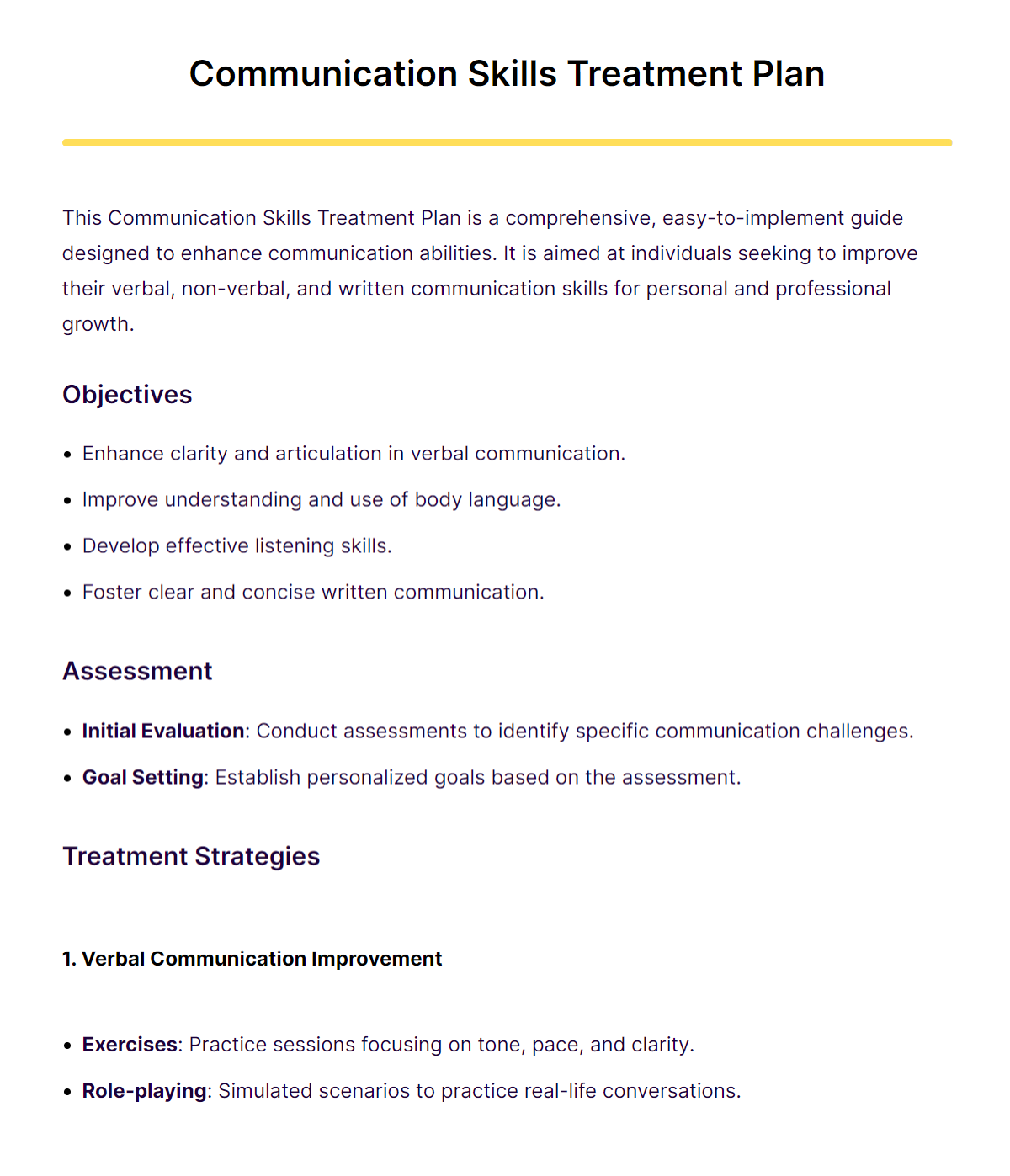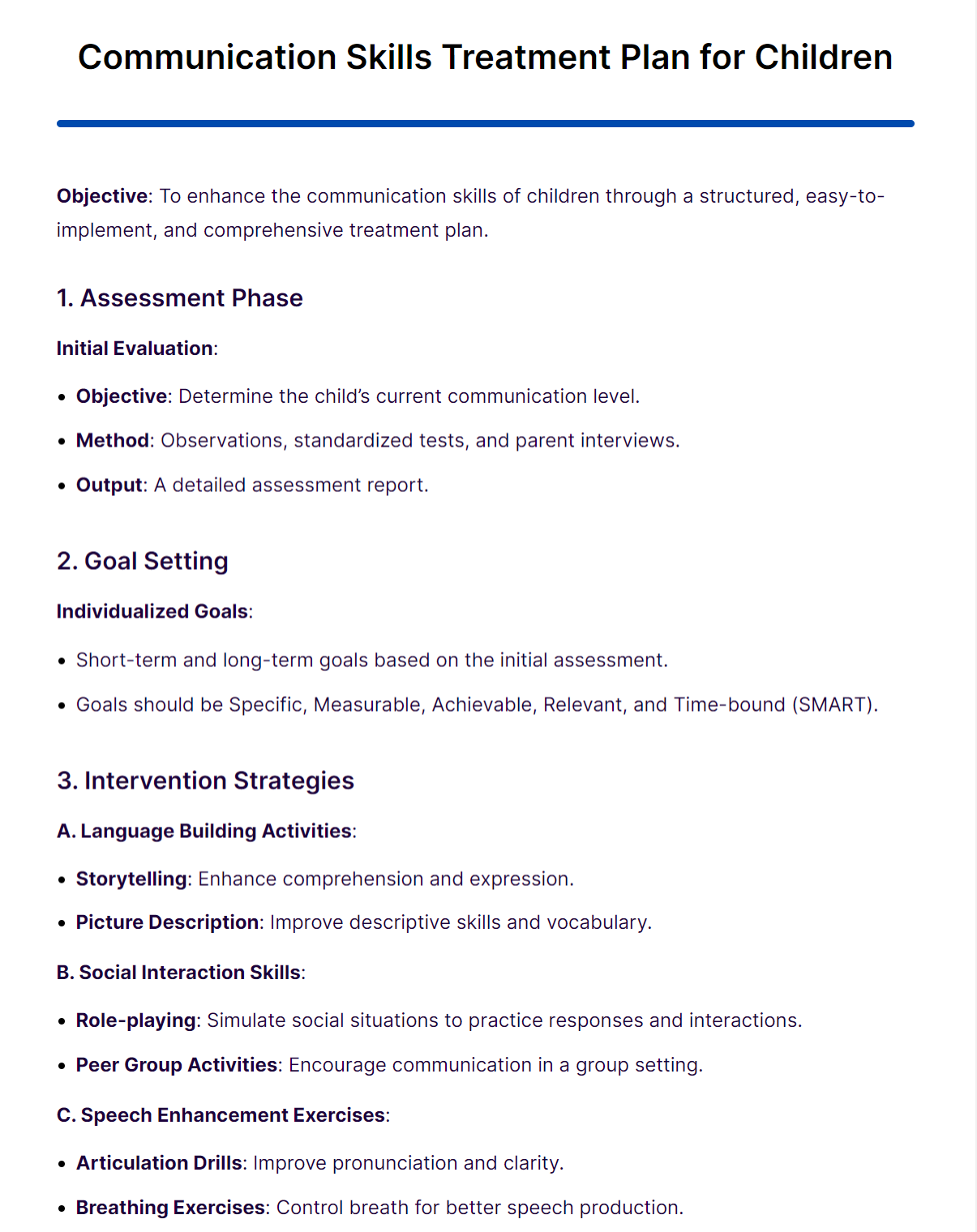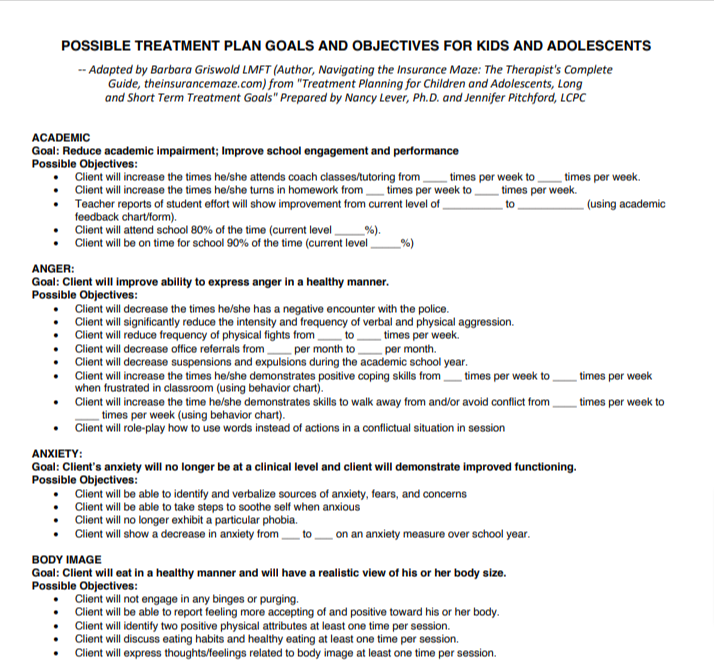4 Communication Skills Treatment Plan Examples
Embark on a transformative journey with our comprehensive guide to a Communication Skills Treatment Plan. This resource is packed with practical Communication Examples and actionable strategies to enhance your verbal and non-verbal skills. Whether in personal relationships or professional settings, our guide provides the insights you need to communicate more effectively, resolve conflicts, and build stronger connections. Dive into a world where every interaction is an opportunity for growth and understanding.
Download Communication Skills Treatment Plan Bundle
Communication Skills Treatment Plan

The document is a detailed guide on creating a Communication Skills Treatment Plan, aimed at enhancing verbal, non-verbal, and written communication for personal and professional growth. It outlines objectives like improving clarity in verbal communication and understanding body language. The plan includes strategies like role-playing and active listening exercises, with a structured implementation timeline. Regular progress tracking, feedback mechanisms, and access to resources ensure the plan’s effectiveness, helping individuals significantly enhance their communication skills.
Communication Skills Treatment Plan for Children

The document outlines a comprehensive Communication Skills Treatment Plan for children, aiming to enhance their skills through structured, easy-to-implement strategies. It begins with an assessment phase to understand the child’s current communication level, followed by setting SMART goals. Intervention strategies include language building, social interaction skills, speech enhancement, and non-verbal communication exercises. The plan emphasizes parental involvement, regular progress monitoring, and adapting based on feedback. Resources like flashcards and storybooks support the learning process
Treatment Plan Goals and Objectives for Communication Skills

theinsurancemaze.com
DownloadCommunication Skills Training Treatment Plan

mirecc.va.gov
DownloadHow to Write Communication Skills Treatment Plan?
Creating a Communication Skills Treatment Plan is pivotal in setting clear objectives and strategies for enhancing your communication skills. This guide provides a step-by-step approach to construct a tailored plan that addresses your specific needs.
- Understanding the Basics: Before diving into writing your plan, understand what a Communication Skills Treatment Plan entails. It’s a structured approach to improve your ability to effectively convey information, understand others, and manage interpersonal dynamics. Recognize the areas you want to focus on, be it verbal communication, active listening, or non-verbal cues.
- Setting Clear Objectives: Begin by setting clear, achievable goals. Whether you’re aiming to enhance your public speaking skills or improve empathy in conversations, having specific communication objectives gives your plan direction. For instance, if your goal is to improve active listening, your objective might be, “Engage in at least two meaningful conversations daily where I solely focus on understanding the speaker’s perspective.”
- Assessment of Current Skills: Conduct a thorough assessment of your current communication abilities. Identify your strengths and areas for improvement. You can do this through self-reflection, seeking feedback from peers, or even professional assessments. Understanding your starting point is crucial for measuring progress.
- Developing Strategies: Once you’ve set your goals and assessed your current skills, it’s time to develop strategies. For each objective, outline specific actions you will take. If your goal is to enhance verbal communication, strategies might include joining a public speaking club, practicing speeches, or taking communication classes.
- Incorporating Learning Resources: Include resources that will aid your learning. This could be books, podcasts, workshops, or online courses focused on communication skills. Resources like ‘Crucial Conversations’ by Al Switzler, Joseph Grenny, and Ron McMillan, or the ‘Speak Up’ podcast can provide valuable insights.
- Regular Practice and Application: Theory without practice is futile. Ensure your plan includes regular practice of the strategies you’ve outlined. This could be daily interactions where you consciously employ your new skills, or regular meet-ups with a mentor or coach to practice and receive feedback.
- Monitoring Progress: Set up a system to monitor your progress. This might involve regular self-assessment, maintaining a journal of your experiences, or scheduled feedback sessions with others. Monitoring helps you stay on track and make necessary adjustments to your plan.
- Seeking Feedback: Feedback is invaluable in a Communication Skills Treatment Plan. Regularly seek constructive feedback from trusted colleagues, friends, or a coach. They can provide insights into how your communication is perceived and offer suggestions for improvement.
- Revising the Plan: As you progress, your needs and focus may shift. Regularly review and adjust your plan to reflect your current goals, challenges, and achievements. A flexible plan is more sustainable and effective in the long run.
Treatment Plan Goals for Communication Skills
Setting specific, achievable goals is the cornerstone of an effective Communication Skills Treatment Plan. These goals provide direction and focus, enabling individuals to measure their progress and stay motivated. Below are key goals that one might include in a treatment plan aimed at enhancing communication skills.
Enhancing Verbal Communication
Goal: Improve clarity and effectiveness in spoken communication. This involves expanding vocabulary, refining speech delivery, and learning the art of persuasion and storytelling. Practicing public speaking or engaging in debate can facilitate this goal.
Strengthening Active Listening Skills
Goal: Develop the ability to listen actively and empathetically. This means not just hearing words but understanding the intent, emotions, and nuances behind them. Techniques include paraphrasing, asking open-ended questions, and providing feedback that shows understanding.
Mastering Non-Verbal Communication
Goal: Gain proficiency in interpreting and using non-verbal cues such as body language, eye contact, and facial expressions. This goal can be met through exercises in mirroring, role-playing, and conscious observation of others’ non-verbal signals.
Improving Written Communication
Goal: Enhance the ability to convey ideas clearly and effectively through writing. This includes grammar and punctuation mastery, style and tone adaptation, and the ability to write concise and compelling content. Regular writing exercises and seeking feedback can aid in achieving this goal.
Managing Communication in High-Pressure Situations
Goal: Develop strategies for maintaining clear and effective communication plan under stress. This involves learning stress-reduction techniques, practicing staying calm and focused, and planning for high-pressure scenarios.
Building Conflict Resolution Skills
Goal: Cultivate the ability to navigate and resolve conflicts through effective communication. This includes understanding different conflict styles, developing negotiation skills, and learning to find common ground and compromise without sacrificing one’s own needs.
Expanding Empathy and Emotional Intelligence
Goal: Increase empathy and emotional intelligence to enhance interpersonal interactions. This involves learning to recognize and understand others’ emotions and perspectives, and adjusting communication accordingly.
Enhancing Cultural Sensitivity
Goal: Develop an awareness and appreciation of cultural differences in communication styles and practices. This goal is met by educating oneself about different cultures, engaging with diverse groups, and practicing respectful and inclusive communication.
Building Assertiveness
Goal: Improve assertiveness in communication, expressing ideas and needs confidently and respectfully. Techniques include using “I” statements, practicing assertive body language, and setting clear boundaries.
Treatment Plan to Improve Communication Skills
Improving communication skills is a journey that involves self-awareness, practice, and a commitment to continuous improvement. This treatment plan outlines a structured approach to enhancing your ability to express yourself clearly, listen actively, and understand others effectively.
Assessment Phase
Objective: Identify specific communication challenges and areas for improvement.
- Self-Evaluation: Reflect on your communication strengths and weaknesses. Consider aspects like clarity, listening, empathy, assertiveness, and non-verbal communication.
- Feedback Gathering: Seek feedback from friends, family, or colleagues about your communication style and areas they think you could improve.
- Professional Assessment: If possible, work with a therapist or a communication coach to get a professional evaluation of your skills.
Goal Setting
Objective: Establish clear, achievable goals for improvement based on the assessment.
- Specificity: Set specific goals like enhancing active listening, improving public speaking, or becoming more assertive in conversations.
- Measurability: Ensure goals are measurable, so you can track your progress. For instance, practice active listening in at least three conversations per day.
Strategy Development
Objective: Develop strategies and activities to meet your goals.
- Educational Resources: Utilize books, online courses, and workshops to learn communication theories and techniques.
- Skill-Specific Activities: Engage in activities that target specific skills, like joining a public speaking club, practicing empathy exercises, or role-playing conflict scenarios.
- Real-Life Application: Apply the strategies in your daily interactions. Set small, daily challenges for yourself, like starting a conversation with a stranger or giving a compliment.
Practice and Application
Objective: Regularly practice the new skills to build proficiency and confidence.
- Consistent Practice: Dedicate time each day to practice your communication skills in various settings, such as at work, home, or social events.
- Journaling: Keep a journal of your experiences, challenges, and progress. Reflect on what worked well and what you could do differently next time.
Feedback and Adjustment
Objective: Seek feedback and make necessary adjustments to your approach.
- Regular Feedback: Regularly ask for feedback from people you interact with. Understand their perspective on your communication style and improvements.
- Self-Reflection: Reflect on your progress and any challenges you’re facing. Be honest with yourself about what’s working and what’s not.
Review and Adapt
Objective: Periodically review the plan and adapt it based on progress and changing needs.
- Progress Review: Every few weeks, review your progress towards your goals. Celebrate successes and analyze any setbacks.
- Plan Adaptation: Adjust your strategies and goals as needed. As you improve, you might find new areas to focus on or different techniques to try.
Support System
Objective: Build a support system to encourage progress and hold you accountable.
- Mentors and Peers: Connect with mentors or peers who can provide guidance, encouragement, and constructive criticism.
- Professional Help: If you’re struggling with specific aspects, consider seeking help from a therapist or a communication coach
How can Treatment Plan help Communication Skills?
Sets Clear Goals
A Treatment Plan defines specific objectives, focusing your efforts on precise areas of improvement like active listening or verbal clarity, making progress easier to track and achieve.
Customizes Strategies
It tailors strategies to individual needs, offering exercises and techniques suited to your unique communication challenges, ensuring a more effective improvement process.
Encourages Practice
Regular practice is key, and a Treatment Plan structures this practice into your routine, helping build confidence and proficiency in communication over time.
Incorporates Feedback
Feedback is vital. The plan includes mechanisms for receiving feedback, helping you understand others’ perceptions and adjust your approach accordingly.
Promotes Self-Reflection
Self-reflection is encouraged, allowing you to assess your interactions and progress, leading to a deeper understanding and continuous improvement.
Provides Structure
The plan breaks down the complex goal of enhancing communication into manageable steps, offering a clear and structured path to improvement.
Supports Adaptability
As your skills and needs evolve, the Treatment Plan adapts, ensuring it remains relevant and effective at all stages of your development.
Enhances Accountability
Committing to a Treatment Plan increases accountability, motivating you to persist and continually improve your communication skills.
Treatment Plan for Improving Communication Skills
Improving communication skills is a journey that involves self-awareness, practice, and a commitment to continuous improvement. This treatment plan outlines a structured approach to enhancing your ability to express yourself clearly, listen actively, and understand others effectively.
Assessment Phase
Objective: Identify specific communication challenges and areas for improvement.
- Self-Evaluation: Reflect on your communication strengths and weaknesses. Consider aspects like clarity, listening, empathy, assertiveness, and non-verbal communication.
- Feedback Gathering: Seek feedback from friends, family, or colleagues about your communication style and areas they think you could improve.
- Professional Assessment: If possible, work with a therapist or a communication coach to get a professional evaluation of your skills.
Goal Setting
Objective: Establish clear, achievable goals for improvement based on the assessment.
- Specificity: Set specific goals like enhancing active listening, improving public speaking, or becoming more assertive in conversations.
- Measurability: Ensure goals are measurable, so you can track your progress. For instance, practice active listening in at least three conversations per day.
Strategy Development
Objective: Develop strategies and activities to meet your goals.
- Educational Resources: Utilize books, online courses, and workshops to learn communication theories and techniques.
- Skill-Specific Activities: Engage in activities that target specific skills, like joining a public speaking club, practicing empathy exercises, or role-playing conflict scenarios.
- Real-Life Application: Apply the strategies in your daily interactions. Set small, daily challenges for yourself, like starting a conversation with a stranger or giving a compliment.
Practice and Application
Objective: Regularly practice the new skills to build proficiency and confidence.
- Consistent Practice: Dedicate time each day to practice your communication skills in various settings, such as at work, home, or social events.
- Journaling: Keep a journal of your experiences, challenges, and progress. Reflect on what worked well and what you could do differently next time.
Feedback and Adjustment
Objective: Seek feedback and make necessary adjustments to your approach.
- Regular Feedback: Regularly ask for feedback from people you interact with. Understand their perspective on your communication style and improvements.
- Self-Reflection: Reflect on your progress and any challenges you’re facing. Be honest with yourself about what’s working and what’s not.
A Communication Skills Treatment Plan begins with a thorough evaluation to assess current strengths and areas for improvement. This phase, known as Communication Skills Evaluation, involves observing, testing, and interviews to develop a nuanced understanding of an individual’s communicative abilities. Following this, Treatment Planning tailors specific strategies and exercises to address identified needs. The plan may include a variety of techniques ranging from verbal articulation exercises, active listening practice, to non-verbal communication enhancement. The ultimate aim is to provide a comprehensive roadmap that guides individuals through a structured process of improving their communication skills, thereby enriching their personal and professional interactions.
Communication skills training for mental health is crucial in today’s world. It helps individuals express their thoughts and emotions effectively, facilitating better understanding and support. In the United States, where mental health awareness is on the rise, such training is in high demand.



